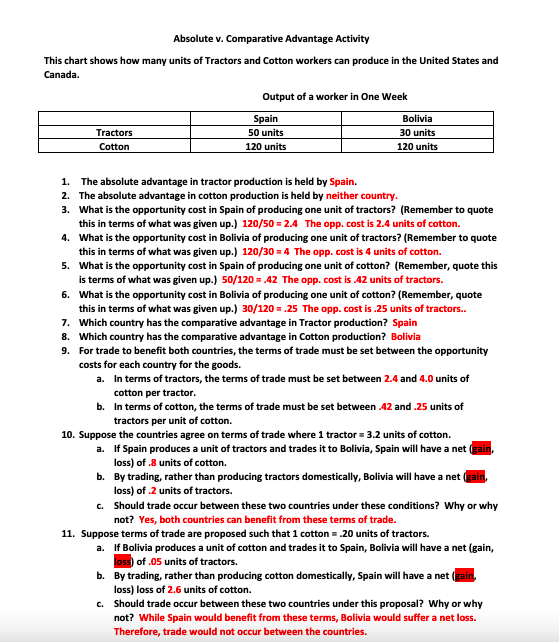Absolute v. Comparative Advantage Activity This chart shows how many units of Tractors and Cotton workers can produce in the United States and Canada. Output of a worker in One Week Spair Bolivia Tractors 50 units 30 units Cotton 120 units 120 units . The absolute advantage in tractor production is held by Spain. The absolute advantage in cotton production is held by neither country. 3. What is the opportunity cost in Spain of producing one unit of tractors? (Remember to quote this in terms of what was given up.) 120/50 = 2.4 The opp. cost is 2.4 units of cotton. 4. What is the opportunity cost in Bolivia of producing one unit of tractors? (Remember to quote this in terms of what was given up.) 120/30 = 4 The opp. cost is 4 units of cotton. What is the opportunity cost in Spain of producing one unit of cotton? (Remember, quote this is terms of what was given up.) 50/120 = .42 The opp. cost is .42 units of tractors What is the opportunity cost in Bolivia of producing one unit of cotton? (Remember, quote this in terms of what was given up.) 30/120 = .25 The opp. cost is .25 units of tractors.. 7. Which country has the comparative advantage in Tractor production? Spain 8. Which country has the comparative advantage in Cotton production? Bolivia For trade to benefit both countries, the terms of trade must be set between the opportunity costs for each country for the goods. a. In terms of tractors, the terms of trade must be set between 2.4 and 4.0 units of cotton per tractor. In terms of cotton, the terms of trade must be set between .42 and .25 units of tractors per unit of cotton. 10. Suppose the countries agree on terms of trade where 1 tractor = 3.2 units of cotton. If Spain produces a unit of tractors and trades it to Bolivia, Spain will have a net (gain, loss) of & units of cotton. b. By trading, rather than producing tractors domestically, Bolivia will have a net (gain loss) of .2 units of tractors c. Should trade occur between these two countries under these conditions? Why or why not? Yes, both countries can benefit from these terms of trade. 11. Suppose terms of trade are proposed such that 1 cotton = .20 units of tractors. a. If Bolivia produces a unit of cotton and trades it to Spain, Bolivia will have a net (gain, oss) of .05 units of tractors. b. By trading, rather than producing cotton domestically, Spain will have a net (gain loss) loss of 2.6 units of cotton. C. Should trade occur between these two countries under this proposal? Why or why not? While Spain would benefit from these terms, Bolivia would suffer a net loss. Therefore, trade would not occur between the countries







